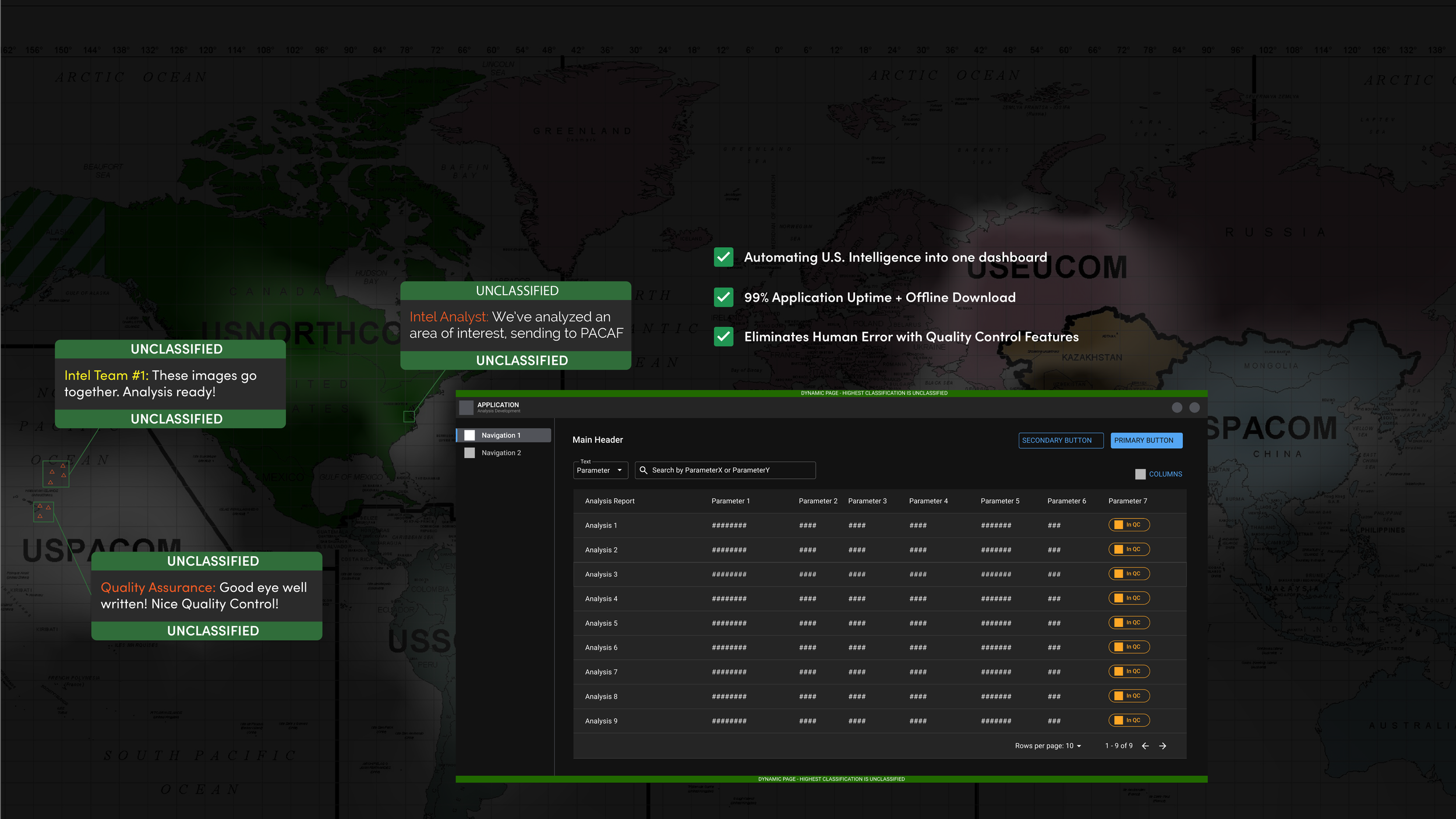
Product Strategist | Designer Kessel Run
Geospatial Intel Tool
Implemented the first desktop-based app for the US Air Force to analyze and publish Intelligence Reports
Context:
Kessel Run is a Department of Defense software innovation factory in Boston, MA. Built by government employees and Air Force Officers, we apply agile methodology to solve the next day's problems in a waterfall industry.
Overview:
Kessel Run’s Geospatial Intel Tool is a report builder that condenses key artifacts in intelligence to tie elements from different databases and types of intelligence, which saves time and prevents analysis paralysis from cognitive overload.
In just 3 months, I adopted more than 70% of the user base by identifying critical gaps between user needs and software capability.
I implemented 3 key initiatives: User Feedback, Onboarding & Training Sessions, and High-Impact In-App Features.
Our app team’s success is due to the trust we built with our warfighting partners.
I am forever grateful for having such an amazing development team and the airmen who championed and co-built this software.
*Due to the Privacy Act of 1974, as a federal employee, I cannot disclose certain details, including names and procedures, etc.
Problem
Replacing a Manual Process
Imagine working in a field where every piece of writing needs to be succinct and precise. This is the workflow of a typical U.S. Intel Officer.
How do we ensure the writing is accurate, error-free, and easy to read?
The current experience made the user go searching for information in multiple different locations often causing analysis paralysis and increased cognitive load. This involved manual labor, including tedious in-person communication, using Microsoft Word & Excel to track work and Logging into different websites to input this data.
Back in 2022, Kessel Run recieved funding to go build an all-in-one report builder. In 2024, we reached “MVP” by an agreed definition by our stakeholders, yet we lacked user adoption.
Overview - Product Space
NEXT SECTION: DESIGNS
| GEOSPATIAL INTEL ANALYSIS TOOL |
NEXT SECTION: DESIGNS | GEOSPATIAL INTEL ANALYSIS TOOL |
Design
Report Builder
These were some of the Key Features of the GIT Report Builder: AI Solver, Autofill,
DDIL(Online/Offline Options), QA, and ACL Database Connection.
Final Delivered Products
Writing Aid for New Analyst
How do you ensure quality across experience analysts to those just starting the job?
Writing Aid: Classification and Legal Safety
We created a safe space for new analysts to train in called Writing Aid. One of the coolest features in Writing Aid is the AI partnership between our team and Air Force Research Labs (AFRL), which identifies all the classifications in the document and auto-formats the highest one for legality
Writing Aid Demo: Adding Prompts
From analyzing the legal documentation from Headquarters Air Force, we included every possible prompt that would keep the analyst from writing anything out of scope. This allows the user to focus on writing only the relevant pieces of information.

Building QC Checklist: Cupcake to…
With our agile methodology, we build for scale. We were busy building several other features and the QCer process was a large request. We stole Parabol’s product strategy stack and built a more comprehensive report builder(cupcake). Soon after, the Quality Control Panel(birthday cake) allowed us to adopt an entirely new user group. Shown below are examples of birthday cake feature sets.
Birthday Cake Feature: QC Checklist Demo
We built for scale, and while we didn’t know it then, we kept the right-hand side light for future development. Introducing our Cupcake to Wedding Cake Strategy: We built the Report Builder as a workspace for building reports(cupcake). With the new QC workflow(birthday cake), we were ready to gain global adoption(wedding cake).
Birthday Cake Feature: Spell Check & Grammar
In mid-October, I collected feedback 3 times a week in 3 different environments where our users work. After talking to a new user segment(Quality Control Analysts), I realized they had a difficult job balancing Jira boards, assigning people work, and checking the quality of writing. We introduced Spell Check and Grammar to lighten their load.
Wedding Cake: An All-In-One Report Builder
Reflection
Key Takeaways
1. Trust and Communication Are Foundational
Building from zero means navigating uncertainty and rapid change. Trust within the team and with stakeholders enables honest conversations, quick feedback, and the confidence to take risks. Open, frequent communication ensures alignment and keeps everyone moving toward the same goal.
Show up often and ready, and like in any relationship, the energy you bring to the table sets the foundation for a great partnership.
2. Assumptions Kill
If you read my blog post about my journey on this team, you’ll read more about how assumptions are silent blockers. They led to wasted effort and missed opportunities. Sometimes you have to build in ambiguity, but one of our supposed “problem child” user groups ended up being the tipping point in adoption, signaling the start of a new workflow process using our software.
When you work with such a talented team, and you trust their instinct and research, it’s less likely that you will validate their assumptions. We focused so much on stakeholder requirements that the product was not truly usable.
3. We Ship Solutions, Not Features
In a military organization, the stakes are high and the mission always comes first. This means our focus isn’t on rolling out the most tools or the flashiest technology. We deliver solutions that directly support the mission and the people carrying it out. Every initiative, system, or process we implement must solve real problems for service members and enhance operational effectiveness.









